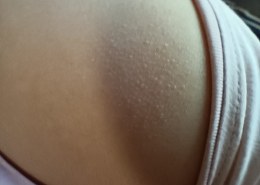I recently fell sick and I’m getting this very sharp pain in my nostrils. It’s like dry and cold? I’m not congested but it feels very painful and deep inside. But not inside my head like where my sinus is. ...
Thanks for sharing the image of the skin problem in question. It is difficult to give specific advice without a proper skin examination. It looks like a benign skin rash on an area of pigmented skin. It is better to consult a dermatologist in person to have a proper examination and decide on the diaRead more
Thanks for sharing the image of the skin problem in question. It is difficult to give specific advice without a proper skin examination. It looks like a benign skin rash on an area of pigmented skin. It is better to consult a dermatologist in person to have a proper examination and decide on the diagnosis and treatment
Dr Joyce Lim
Consultant Dermatologist
Joyce Lim Skin & Laser Clinic
http://www.joycelim.com
The information provided on this forum is for educational purposes only and not intended as medical advice. Please consult a healthcare provider for any medical concerns, diagnosis or treatment.
See less

Experiencing sharp pain in the nostrils, especially when it feels dry and cold, can be quite uncomfortable. This type of pain can be attributed to several potential causes, and understanding these can help guide appropriate management strategies. Potential Causes: 1. Nasal Dryness and Irritation: -Read more
Experiencing sharp pain in the nostrils, especially when it feels dry and cold, can be quite uncomfortable. This type of pain can be attributed to several potential causes, and understanding these can help guide appropriate management strategies.
Potential Causes:
1. Nasal Dryness and Irritation:
– Environmental Factors: Exposure to dry air, particularly in heated indoor environments during colder months, can lead to nasal dryness. This can cause the mucous membranes to become irritated and painful.
– Dehydration: Inadequate fluid intake can exacerbate dryness in the nasal passages.
– Medications: Certain medications, such as antihistamines or decongestants, can dry out the nasal passages.
2. Nasal Vestibulitis:
– This is an inflammation of the nasal vestibule, the area just inside the nostrils. It can be caused by bacterial infections, often due to Staphylococcus aureus, and can result in sharp pain and tenderness.
3. Nasal Trauma or Foreign Body:
– Minor trauma from nose picking or the presence of a foreign body can cause localized pain and irritation.
4. Allergic Rhinitis:
– Although typically associated with congestion, allergic rhinitis can sometimes cause irritation and a sensation of dryness, especially if there is frequent nose blowing or sneezing.
5. Chemical Irritants:
– Exposure to irritants such as smoke, strong odors, or pollutants can cause nasal discomfort and dryness.
Management Strategies:
1. Humidification:
– Use a humidifier in your living space to add moisture to the air, which can help alleviate dryness in the nasal passages.
2. Nasal Saline Sprays or Rinses:
– Regular use of saline sprays or rinses can help keep the nasal passages moist and clear of irritants. This can also aid in soothing irritation.
3. Hydration:
– Ensure adequate fluid intake to maintain overall hydration, which can help keep mucous membranes moist.
4. Avoid Irritants:
– Minimize exposure to known irritants such as smoke, strong perfumes, or harsh cleaning chemicals.
5. Topical Treatments:
– Consider using a nasal emollient or ointment, such as petroleum jelly, applied gently inside the nostrils to provide a protective barrier and reduce dryness.
6. Medical Consultation:
– If the pain persists or is accompanied by other symptoms such as fever, swelling, or discharge, it would be prudent to consult a healthcare professional. They can assess for conditions like nasal vestibulitis or other infections that may require specific treatments, such as antibiotics.
Considerations:
– Monitor Symptoms: Keep track of any additional symptoms that may develop, such as changes in discharge, swelling, or systemic symptoms like fever, which could indicate an infection.
– Specialist Referral: If symptoms do not improve with initial measures, a referral to an otolaryngologist (ENT specialist) may be warranted for further evaluation.
By addressing the underlying cause, you can effectively manage the symptoms and alleviate the discomfort. If you have any concerns about specific treatments or if symptoms worsen, seeking professional medical advice is recommended.
See less